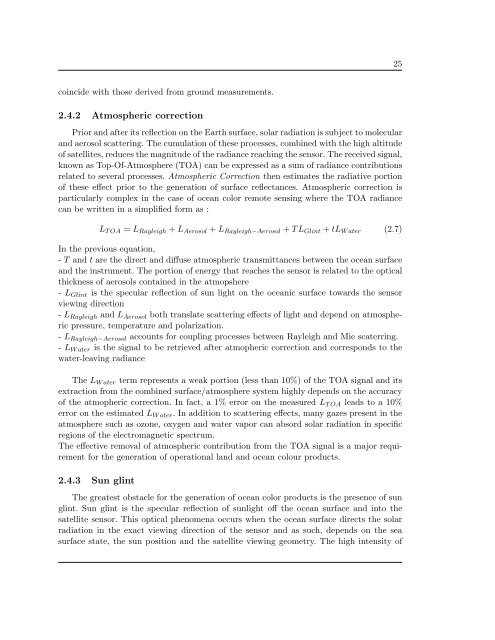Th`ese Marouan BOUALI - Sites personnels de TELECOM ParisTech
Th`ese Marouan BOUALI - Sites personnels de TELECOM ParisTech
Th`ese Marouan BOUALI - Sites personnels de TELECOM ParisTech
Create successful ePaper yourself
Turn your PDF publications into a flip-book with our unique Google optimized e-Paper software.
25<br />
coinci<strong>de</strong> with those <strong>de</strong>rived from ground measurements.<br />
2.4.2 Atmospheric correction<br />
Prior and after its reflection on the Earth surface, solar radiation is subject to molecular<br />
and aerosol scattering. The cumulation of these processes, combined with the high altitu<strong>de</strong><br />
of satellites, reduces the magnitu<strong>de</strong> of the radiance reaching the sensor. The received signal,<br />
known as Top-Of-Atmosphere (TOA) can be expressed as a sum of radiance contributions<br />
related to several processes. Atmospheric Correction then estimates the radiative portion<br />
of these effect prior to the generation of surface reflectances. Atmospheric correction is<br />
particularly complex in the case of ocean color remote sensing where the TOA radiance<br />
can be written in a simplified form as :<br />
L T OA = L Rayleigh + L Aerosol + L Rayleigh−Aerosol + TL Glint + tL W ater (2.7)<br />
In the previous equation,<br />
- T and t are the direct and diffuse atmospheric transmittances between the ocean surface<br />
and the instrument. The portion of energy that reaches the sensor is related to the optical<br />
thickness of aerosols contained in the atmopshere<br />
- L Glint is the specular reflection of sun light on the oceanic surface towards the sensor<br />
viewing direction<br />
- L Rayleigh and L Aerosol both translate scattering effects of light and <strong>de</strong>pend on atmospheric<br />
pressure, temperature and polarization.<br />
- L Rayleigh−Aerosol accounts for coupling processes between Rayleigh and Mie scaterring.<br />
- L W ater is the signal to be retrieved after atmopheric correction and corresponds to the<br />
water-leaving radiance<br />
The L W ater term represents a weak portion (less than 10%) of the TOA signal and its<br />
extraction from the combined surface/atmosphere system highly <strong>de</strong>pends on the accuracy<br />
of the atmopheric correction. In fact, a 1% error on the measured L T OA leads to a 10%<br />
error on the estimated L W ater . In addition to scattering effects, many gazes present in the<br />
atmosphere such as ozone, oxygen and water vapor can absord solar radiation in specific<br />
regions of the electromagnetic spectrum.<br />
The effective removal of atmospheric contribution from the TOA signal is a major requirement<br />
for the generation of operational land and ocean colour products.<br />
2.4.3 Sun glint<br />
The greatest obstacle for the generation of ocean color products is the presence of sun<br />
glint. Sun glint is the specular reflection of sunlight off the ocean surface and into the<br />
satellite sensor. This optical phenomena occurs when the ocean surface directs the solar<br />
radiation in the exact viewing direction of the sensor and as such, <strong>de</strong>pends on the sea<br />
surface state, the sun position and the satellite viewing geometry. The high intensity of















